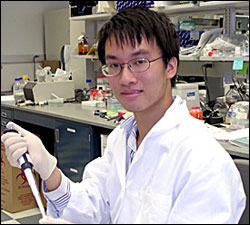
Laser Blasts Viruses in Blood
BALTIMORE, Md., Sept. 4, 2007 -- A walk in the park led to a new use for lasers: zapping viruses out of blood. The technique, which holds promise for disinfecting blood for transfusions, uses a low-power laser beam with a pulse lasting just fractions of a second.
Johns Hopkins University student Shaw-Wei David Tsen said the idea was born during a stroll in the park with his father. Tsen, an undergraduate working in the laboratory of T.C. Wu at Johns Hopkins' Kimmel Cancer Center, was looking for a new way to rid isolated blood of pathogens such as the HIV and hepatitis C viruses. Current techniques using ultraviolet irradiation and radioisotopes can leave a trail of mutated or damaged blood components, he said.

Pulsed femtosecond laser system used in the study (exterior view). (Photo courtesy Johns Hopkins University)
Using ultrasonic vibrations to destroy viruses was one possibility, but Tsen's father, Kong-Thon Tsen -- a laser expert at Arizona State University -- had a better idea: Lasers, unlike ultrasound, can penetrate energy-absorbing water surrounding the viruses and directly vibrate the pathogen itself.
The researchers aimed a low-power laser with a pulse lasting 100 femtoseconds (10 to the power of -13 second) into glass tubes containing saline-diluted viruses that infect bacteria, also known as bacteriophages. The amount of infectious virus within each cube plummeted 100- to 1000-fold after the laser treatment.
"I had to repeat the experiment several times to convince myself that the laser worked this well," said the younger Tsen, who is now a junior at Johns Hopkins.
His laser is different from those emitting a continuous beam of visible light. "Our laser repeatedly sends a rapid pulse of light and then relaxes, allowing the solution surrounding the virus to cool off," he said. "This significantly reduces heat damage to normal blood components."

Interior view of the laser. The initial continuous-wave laser beam (green) becomes pulsed (80 femtosecond pulse duration) after striking the Ti-sapphire crystal (bright orange spot in center) and emerges as infrared light. This laser beam then passes through a frequency doubler which converts it into visible (purple) light -- this purple laser beam is used to irradiate the virus samples. (Photo courtesy Johns Hopkins University)
Building on the idea that vibration wrecks a virus' outer shell, the scientists found that their low-power laser selectively destroys viruses and spares normal human cells around them, while stronger beams kill almost everything.
The pair speculate that laser vibrations could destroy both drug-resistant and -sensitive viruses. Wu said the technique his student developed "could potentially be used to control communicable diseases by giving infusions of laser-treated blood products."
The scientists said they will continue their studies using different viruses. "We believe this work on bacterial viruses is promising, but the real test will be with more serious pathogens like HIV and hepatitis," We said.

Shaw-Wei David Tsen, undergraduate research assistant, discovered the results while assaying for virus kill.
The National Science Foundation funded the research. Additional collaborators include Chih-Long Chang and Chien-Fu Hung from Johns Hopkins and Juliann G. Kiang from the Uniformed Services University of the Health Sciences. Results were published in a recent Journal of Physics: Condensed Matter.
For more information, visit: www.jhu.edu
Published: September 2007